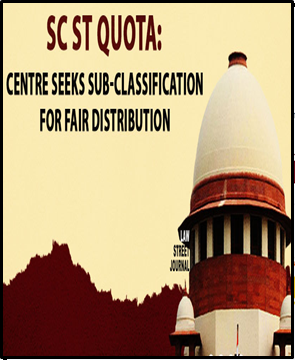SUPREME COURT RULING ON SC/ST QUOTAS
Why in the news?
- The Supreme Court ruled that Scheduled Castes (SCs) and Scheduled Tribes (STs) can be sub-classified by states for reservation purposes.
- A “rational principle” is required for such sub-classification, with a connection to its purpose.
- Four judges favoured excluding the creamy layer from SCs and STs.
About the Supreme Court Verdict on SCs and STs Sub-Classifications:
- Sub-Classifications Permitted: States can sub-classify SCs and STs based on backwardness levels within reservation quotas.
- Empirical Basis: Sub-classifications must be based on data and evidence of systemic discrimination, not political reasons.
- Creamy Layer: Applies the ‘creamy layer’ principle to SCs and STs, excluding more privileged members.
- Reservation Limit: Reservations are limited to the first generation; subsequent generations are ineligible if higher status is achieved.
- Rationale: Aims to address disparities and ensure benefits reach the most disadvantaged members of SCs and STs.
- The court emphasised the use of empirical data and reasonable grounds for sub-classification.
- Sub-classification must withstand judicial scrutiny and avoid “micro-classification.”
- The principle must be relevant and share a nexus with the purpose of sub-classification.
source:scribd
Arguments For Sub-Classification:
Constitutional Provisions:
State Flexibility:
Arguments Against Sub-Classification:
Constitutional Provisions for Weaker Sections:
|




